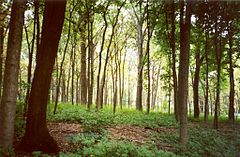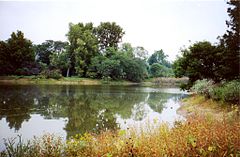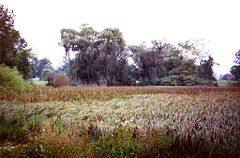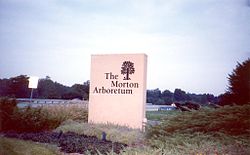- Morton Arboretum
-
The Morton Arboretum, in Lisle, Illinois, covers 1,700 acres (6.9 Square kilometres) and is made up of gardens of various plant types and collections of trees from specific taxonomical and geographical areas. It includes native woodlands[1] and a restored Illinois prairie. The Arboretum has over 4,100 different species of trees, shrubs and other woody plants from around the globe. In all, there are over 186,000 catalogued plants. The Arboretum has 16 miles (26 km) of hiking trails and nine miles (14 km) of roadways for driving/bicycling.
The Arboretum features a 4-acre (16,000 m2) interactive "Children's Garden"[2] and a 1-acre (4,000 m2) "Maze Garden." Other special landscaped areas include the Fragrance Garden, Ground Cover Garden and Hedge Garden. The Schulenberg Prairie[3] is one of the largest restored prairies in the Chicago suburban area.
The Morton Arboretum was listed in 2007 as one of the AIA Illinois 150 Great Places in Illinois [4]
The Arboretum offers an extensive Education Program dedicated to a broader understanding of plants and nature, and ways to improve our world. Classes serve children/family/school groups, encompassing adult programs, certificate and training courses, and a cooperative botany degree program with regional colleges and universities.
 A woodland ecosystem.
A woodland ecosystem.
 Lake margin environment.
Lake margin environment.
 Restored grassland.
Restored grassland.
Contents
Mission
The mission of The Morton Arboretum is to collect and study trees, shrubs, and other plants from around the world, to display them across naturally beautiful landscapes for people to study and enjoy, and to learn how to grow them in ways that enhance our environment.
The Arboretum's goal is to encourage the planting and conservation of trees and other plants for a greener, healthier, and more beautiful world. (Source: The Morton Arboretum)
History
The arboretum was established on 14 December 1922 by Joy Morton, founder of the Morton Salt Company.[5] Joy Morton's Thornhill Estate, established in 1910, formed the basis of the Arboretum's original area. Mr. Morton's father Julius Sterling Morton was the founder of Arbor Day.
Sterling Morton Library
Designed by noted Chicago architect Harry Weese, the Sterling Morton Library constructed in 1963, is located on the east side of The Morton Arboretum adjacent to the Administration Building. Built to house the many resources of the Arboretum, this building honors the memory of Sterling Morton, son of founder, Joy Morton.[6]
The Library’s current holdings include over 27,000 volumes of books and magazines, as well as tens of thousands of non-book items including prints, original art, letters, photographs, landscape plans and drawings. The collections focus on plant sciences, especially on trees and shrubs, gardening and landscape design, ecology with a special interest in Midwestern prairie, savanna, woodland, and wetland ecosystems, natural history and its art and illustration, both art history and techniques. Animal subjects include birds, mammals, and insects. Works abound on the history of plant exploration, and biographies of botanists, horticulturists, and botanical artists. The library’s historic and current nursery catalogs will assist homeowners in finding sources for plants of interest.
The Library's Suzette Morton Davidson Special Collections contains books, artwork, historic nursery catalogs, landscape drawings, photographs, letters, maps and institutional documents. Papers, photographs, manuscripts and other documents of May Theilgaard Watts, Jens Jensen, Marshall Johnson, O.C. Simonds and Donald Culross Peattie are also part of the Special Collections.
The Sterling Morton Library is a member of the Council on Botanical and Horticultural Libraries.
Visitor Center
Built in 2004, the 36,000 sq ft (3,300 m2) Visitor Center is a wide-open portal to launch visitors into the Arboretum’s 1,700-acre (6.9 km2) outdoor museum of trees. Designed by David Woodhouse Architects, its major elements are arranged to shape “inside-out/outside-in” spaces that take advantage of varied views of the Arboretum’s horticultural collections. “Gateway buildings are a [David Woodhouse] specialty, and this one, which shelters an information center, restaurant, gift shop and lecture hall, follows his custom of slipping smaller structures under a dramatic roof element.” [7] The building’s design includes wood representing the Arboretum’s collections and incorporates sustainable features such as permeable pavers in the parking lots and local fieldstone salvaged from a predecessor building.
See also
- Chicago Botanic Garden
- List of botanical gardens in the United States
- List of Museums and Cultural Institutions in Chicago
- North American Plant Collections Consortium
References
- ^ Mullen, William. "Arboretum turning back woodland's natural clock." Chicago Tribune, Jan. 12, 2009. p. 14.
- ^ Botts, Beth. "A breath of fresh air: new Morton Arboretum garden aims to reconnect kids and nature." Chicago Tribune, Sept. 10, 2005, p. 23.
- ^ Swanson, Stevenson. "To grow a prairie, you have to return to the grass roots." Chicago Tribune, Sept. 27, 1987, p. 1.
- ^ [1], 2007
- ^ Ballowe, James. "A great outdoor museum : the story of The Morton Arboretum." Lisle, Ill. : the Arboretum, 2003.
- ^ McCarthy, Marilou. "Memorial to her father: Mrs. Zurcher will build a library in Morton Arboretum." Chicago Daily Tribune, Dec. 6, 1961, p. B13.
- ^ Kamin, Blair. "A journey through the new at The Morton Arboretum" Chicago Tribune, Sept. 26, 2004 p. 5.
External links
Municipalities and communities of DuPage County, Illinois County seat: Wheaton Cities Aurora‡ | Batavia‡ | Chicago‡ | Darien | Elmhurst‡ | Naperville‡ | Oakbrook Terrace | St. Charles‡ | Warrenville | West Chicago | Wheaton | Wood Dale
Villages Addison | Bartlett‡ | Bensenville‡ | Bloomingdale | Bolingbrook‡ | Burr Ridge‡ | Carol Stream | Clarendon Hills | Downers Grove | Elk Grove Village‡ | Glendale Heights | Glen Ellyn | Hanover Park‡ | Hinsdale‡ | Itasca | Lemont‡ | Lisle | Lombard | Oak Brook‡ | Roselle‡ | Schaumburg‡ | Villa Park | Wayne‡ | Westmont | Willowbrook | Winfield | Woodridge‡
Townships Addison | Bloomingdale | Downers Grove | Lisle | Milton | Naperville | Wayne | Winfield | York
Unincorporated
communitiesCloverdale | Eola | Flowerfield | Keeneyville | Lakewood | Medinah | Palisades | York Center
Footnotes ‡This populated place also has portions in an adjacent county or counties
Coordinates: 41°49′0.7428″N 88°4′7.7154″W / 41.816873°N 88.068809833°W
Categories:- Arboreta in Illinois
- Botanical gardens in Illinois
- Lisle, Illinois
- Protected areas of DuPage County, Illinois
Wikimedia Foundation. 2010.

